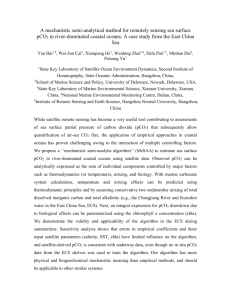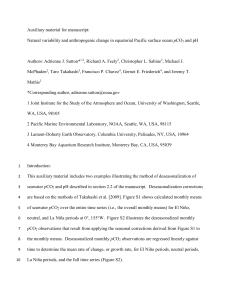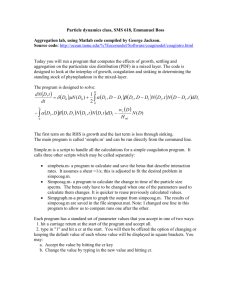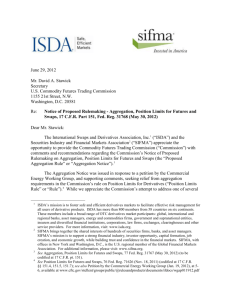Core theme 4: Biogeochemical feedbacks on the oceanic carbon
advertisement
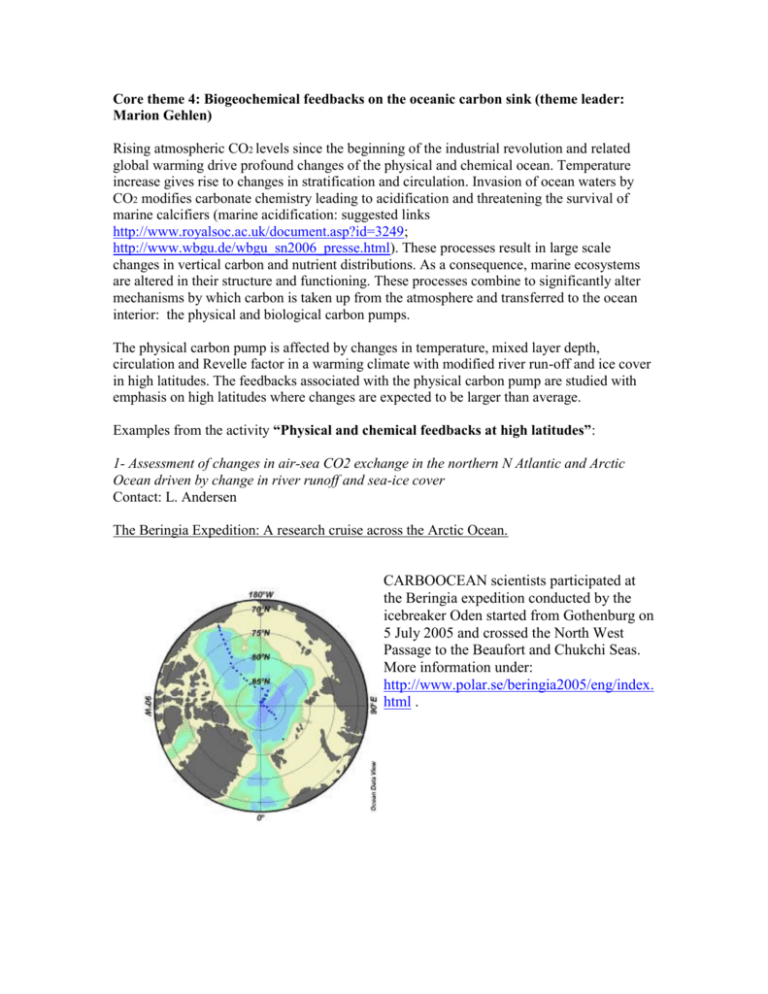
Core theme 4: Biogeochemical feedbacks on the oceanic carbon sink (theme leader: Marion Gehlen) Rising atmospheric CO2 levels since the beginning of the industrial revolution and related global warming drive profound changes of the physical and chemical ocean. Temperature increase gives rise to changes in stratification and circulation. Invasion of ocean waters by CO2 modifies carbonate chemistry leading to acidification and threatening the survival of marine calcifiers (marine acidification: suggested links http://www.royalsoc.ac.uk/document.asp?id=3249; http://www.wbgu.de/wbgu_sn2006_presse.html). These processes result in large scale changes in vertical carbon and nutrient distributions. As a consequence, marine ecosystems are altered in their structure and functioning. These processes combine to significantly alter mechanisms by which carbon is taken up from the atmosphere and transferred to the ocean interior: the physical and biological carbon pumps. The physical carbon pump is affected by changes in temperature, mixed layer depth, circulation and Revelle factor in a warming climate with modified river run-off and ice cover in high latitudes. The feedbacks associated with the physical carbon pump are studied with emphasis on high latitudes where changes are expected to be larger than average. Examples from the activity “Physical and chemical feedbacks at high latitudes”: 1- Assessment of changes in air-sea CO2 exchange in the northern N Atlantic and Arctic Ocean driven by change in river runoff and sea-ice cover Contact: L. Andersen The Beringia Expedition: A research cruise across the Arctic Ocean. CARBOOCEAN scientists participated at the Beringia expedition conducted by the icebreaker Oden started from Gothenburg on 5 July 2005 and crossed the North West Passage to the Beaufort and Chukchi Seas. More information under: http://www.polar.se/beringia2005/eng/index. html . Along with hydrography & tracer work, the C-system parameters total dissolved inorganic carbon, total alkalinity and pH were. First results are shown below: The new results will contribute to evaluate (1) the potential change in the air-sea flux of CO2 driven by decreasing summer sea ice coverage; (2) the inventory of anthropogenic CO2 in the central Arctic Ocean. Examples from the activity “Biological feedbacks”: 1- The sensitivity of air-sea fluxes to remineralization depth: a model study with MPIOM/HAMOCC5.1. The biological pump transfers carbon bound into POC (particulate organic carbon) from the sunlit surface layer to the oceans interior. The time scale at which carbon is subtracted to airsea exchange depends on its depth of remineralization. Time scales range from days for shallow remineralization in well mixed waters to geological time scales for the fraction buried in marine sediments. While the link between penetration depth of POC and air-sea fluxes is conceptually established, it has so far not been quantified. Model experiments with MPIOM/HAMOCC5.1 (http://edoc.mpg.de/249293) Contact: E. Maier-Reimer & J. Segschneider In HAMOCC5.1 settling velocities for particulate matter are prescribed rather than penetration depth profiles. At MPI-Met in Hamburg experiments were performed with two different settling velocities of 5 m/day and 10 m/day and also with an aggregation scheme. Three experiments with the MPIOM/HAMOCC5.1 global oceanic/biogeochemical model were performed over 100 years each. Here results are shown for settling velocities of 5 m/day and 10 m/day on the one hand and an aggregation scheme (Kriest et al., 2000) on the other hand. The respective globally averaged surface pCO2 at the end of the integrations is 288.5, 287.9, and 281.2 ppm for 10m/day, 5m/day, and the aggregation scheme experiment. From this it can be concluded that indeed the modelling of the settling of particles is of importance for the surface pCO2. The resulting difference in surface pCO2 is shown in Fig. 1. While the difference between 5m/day and 10m/day is relatively small in amplitude and on small scales (Fig. 1a), the difference to the aggregation scheme run is much larger, both in amplitude and scale(Fig. 1b). In particular in areas of high biological production, the pCO2 in the aggregation experiment is lower. The main reason for this is a stronger export of POC in the aggregation scheme experiment (enhancement of the biological pump). Fig 1a: difference in surface pCO2: settling velocity 5m/day minus 10 m/day5m/d minus aggregation Fig 1b: difference in surface pCO2: settling velocity 5m/day minus aggregation scheme 2-Strength of CO2 sink associated with the rate of N fixation depending on iron and phosphorus input by dust. Contact: R. Geider, C. Moore & J. LaRocha CARBOOCEAN scientists participated at the Atlantic Meridional Transect (AMT17) (October/November 2005) (left panel). Below results are presented from experimental work in the South Atlantic Gyre. The response of phytoplankton to nutrient addition was addressed by the amendment of phytoplankton samples with nutrients either isolated (P, Fe, N) or in combination (P+Fe,N+P+Fe etc), as well as a sample of dust and rain (right panel). The rain was collected beneath the Saharan dust plume/ITCZ. l Key new findings are : 1) N-limitation of phytoplankton in the South Atlantic sub-tropical gyre. 2) No evidence for Fe limitation of phytoplankton in the South Atlantic sub-tropical gyre. 3) Evidence that atmospheric dry or wet deposition (dust or rain) would have the potential to relieve N limitation.


